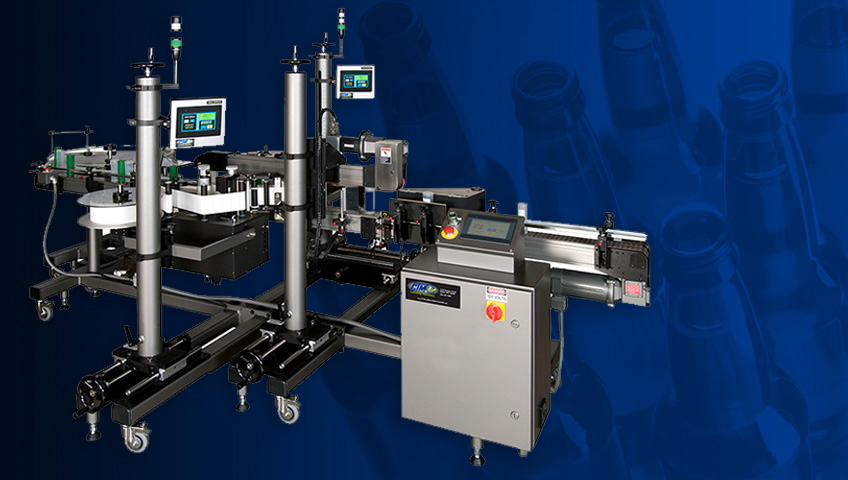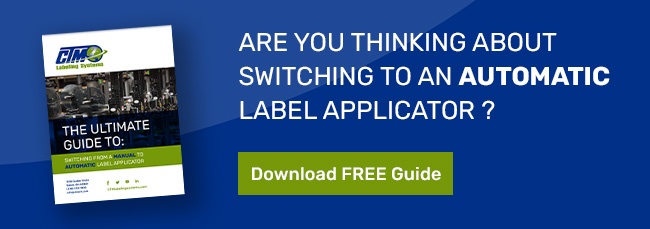
Wrap Around Labeling Machines: Everything You Need to Know
A wrap around labeler is often a great choice for businesses that use round bottles or containers. In fact, thanks to new technologies, wrap around labels can replace more expensive shrink wrapping by offering easy application (which reduces costs on machinery while speeding up production).
So, let’s take a look at how a wrap around labeling machine can streamline production.
What is a Wrap Around Labeling Machine?
When was the last time you drank a beer from a glass bottle, taken medication, applied skin cream, or used liquid hand soap? There’s a good chance that all of those containers were labeled with high-speed, wrap around bottle labeling machines.
–> Get the Ultimate Guide to Switching From A Manual To Automatic Label Applicator
Wrap around labeling systems apply labels by rolling them onto the surface of the container. This application method is less complex than pick-and-place methods and provides similar results to shrink-wrap. While wrap around labels dominate the round bottle market, this type of label can be used on almost any container. (They adhere to plastic, glass, metal and cardboard.)
Wrapping the label around the circumference of the container maximizes printable space. When packaging beverages, this process allows you to place all necessary brand information on a single label and easily meet UPC specifications.
The label is applied in one step. The process is far less complex than many other alternatives and can result in time and money savings (not to mention that using a single label per product also saves money when ordering labels).
So, what size of business can best utilize a wrap around labeling machine?
The good news is that this application method is easy to scale. Small businesses can use a lower cost machine when they first move away from manual labeling (like our 360a Series Wrap System – designed to be a cost-effective, low entry solution), and larger operations can design a high-performance labeler that works faster and accommodates several points of label application (like our Front/Back/Wrap Labeling System).
Wrap Around vs. Shrink Wrap Labeling Systems
For large scale production, shrink wrap labels can offer a cost advantage over wrap labels. They can also provide nearly 100% coverage of the container, giving more space to add graphics and information. However, minimum orders from plastic suppliers are high, and the process of applying these labels is complicated. These complications increase equipment costs and can cause production problems as the labeling machine and heat shrink oven must work in sync to deliver consistent labeling performance.
Wrap labels, on the other hand, are often more durable than shrink wrap because they rely on adhesives rather than fit to stay on the container. This makes wrapping a better choice for containers that experience abrasion and other forms of damage during use.
Unlike shrink wrap labels, wrap adhesive labels can also be made of materials that are compatible with PET plastic recycling. This lets the consumer put the container in their recycling without removing the label.
In recent years, wrap labels have seen a surge in popularity thanks to the adoption of BOPP (biaxially-oriented polypropylene). This stretched plastic can have a variety of surface finishes and colors, including translucent and semi-translucent, and is easy to print on. BOPP is also waterproof, resistant to physical and chemical damage, and handles varying temperature and humidity levels with ease (giving it the appearance of a shrink label without the disadvantages).
Use Cases for Wrap Around Labeling Machines
Round Bottles: This is the most common use for these labels. The wrap application method lends itself to use on round containers, so these particular labels can be seen on everything from medicines to wine bottles.
Beer Cans: Using labels with brites allows you to produce cans that have an appearance similar to printed cans with lower volumes and lower equipment costs. This makes labeling a great choice for seasonal and limited run products, and it makes cans an option for small producers like craft brewers.
Vials: Wrap around labels maximize the surface area on small containers, letting you add the information you need despite the smaller products.
Pharmaceuticals: Combining a wrap labeler with a print engine can allow businesses to print and apply individual labels to prescription bottles.
Creating a Compatible Label
The first step in adding a wrap around labeling system to your production line is deciding what type of label you will use. You can have a label that covers the entire diameter of the container, or just part of it.
A standard labeling machine can only apply a label to the flat side of the container. With a customized machine, however, you can apply labels to areas with simple curves, or add a second label elsewhere on the container. This is a common technique for labeling glass wine and beer bottles: one label goes around the body of the bottle, and a second around the neck.
As a general rule of thumb, there should be an 1/8 to ¼ inch gap between the shoulder and the label to compensate for small variations in positioning. These labels aren’t directional, making size more important than positioning when it comes to what’s printed on the label. For example, if you want the customer to see just the logo when the product is on a shelf, then the logo must cover 50% of the bottle’s circumference.
Tapered containers often need matching tapered labels to compensate for curves. (Even flat-appearing plastic containers have a slight taper to help them release from their molds during manufacturing.) However, rectangular labels can be applied straight by making adjustments to the application angle. A labeling machine manufacturer like CTM Labeling Systems can help with this process and figure out what is needed for a perfect application each and every time.
Choosing a Wrap Around Labeling System
No matter which automatic labeling machine you choose, it will operate using the same basic principles.
The bottle/container enters the labeling machine and passes between two conveyor belts. One belt rolls the label off of the backing and holds it against the container. The other belt spins the container over the label. These two actions move the container forward while applying the pressure needed to create a tight bond with the label adhesive.
The bottle/container enters the labeling machine on a single conveyor. The labeler dispenses a pressure sensitive label into the wrap belt station where the leading edge will be attached in the nip between the product and wrap belt entry. The labeler then continues to feed the label while the product rotates along the wrap belt for full application. After labeling, the product exits the conveyor for customer take away or can continue through the handling system.
Our 360a labeling machine can be configured for a variety of label and container sizes. This is a great choice if you’re going from manual to automatic labeling and want a machine that can handle all of your products.
However, specialization means simpler configuration and faster production. For example, our wine bottle labeler is designed around standard wine bottle sizes. By reducing the number of options, this machine is easy to set up for production.
Make the Switch to a Wrap Around Labeler
Do these wrap labels sound like the right solution for your production needs? If so, contact CTM Labeling Systems. Our local distributors will work with you to set up a wrap around labeling machine that delivers results and fits seamlessly into your production system.





